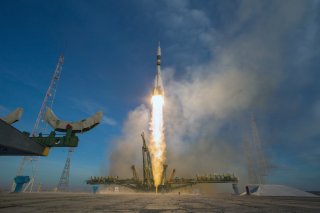After Ban Treaty with Russia Fails, U.S. Weapons are Reaching for New Heights
The Army has again shot off a new generation of land-fired missiles intended to extend the attack range and precision-targeting ability of ground forces on the move.
Here’s What You Need to Remember: "Our adversaries have watched us and learned how we fight. They have invested in areas to offset our advantage.”
The Army has again shot off a new generation of land-fired missiles intended to extend the attack range and precision-targeting ability of ground forces on the move.
The service’s Precision Strike Missile (PrSM) reportedly broke new records after being fired off during a test at Vandenberg Space Force Base in California. The successful test was a substantial step forward for the weapon, which is expected to change the paradigm for ground warfare against enemy ground installations, equipment, air defenses, command and control structures and even moving targets.
The test-firing successfully exceeded previously achieved ranges of distance, according to a statement that PrSM maker Lockheed Martin issued to The Drive. The missile traveled farther than four hundred kilometers, the statement. Now, the weapon is going through what is known as the engineering, manufacturing and development phase. This is a key testing and development step intended to prepare the weapon for deployment in 2023.
The missile previously flew a distance of four hundred kilometers in a test flight earlier this year at White Sands Missile Range in New Mexico. The length of distance achieved in the most recent test has not been made available to the public. However, Lockheed Martin claims the test accomplished a breakthrough. The final or next flight test for the weapon will take place at Project Convergence later this year as preparation for an Increment-2 PrSM capability award, according to Lockheed Martin. Increment 2 is intended to break new ground yet again by demonstrating that the weapon can hit moving targets.
Given the technological dimensions and capabilities of the weapon, which Army leaders describe as a post-Intermediate-Range Nuclear Forces Treaty weapon, the Army will likely adjust tactics, strategies and key elements of its combined arms maneuver strategy.
Following Russia’s violation of the treaty, which previously put limitations on mid-range missiles of this kind, the U.S. Army has been testing and developing a number of ground-fired weapons capable of attacking at new ranges. In fact, Army Futures Command Commander Gen. John Murray specifically noted that PsM represents a specific effort to move beyond previous range restrictions due to treaty violations. A weapon that can travel roughly five hundred kilometers does make possible a mid-range attack relevant in places like Europe, which is home to many U.S.-allied countries. The Army’s new land missile is able to travel those distances and is expected to “out range” the enemy’s missiles, posing a risk to the enemy while reducing the risk of an enemy strike or counterattack.
Brig Gen. John Raffery, the director of the Army's Long Range Precision Fires Cross-Functional Team, previously explained to the National Interest that longer-range offensive weapons help the military service refine its approach to a modern combined arms maneuver strategy.
“Long-range fires can suppress and neutralize enemy integrated air defenses and enable combined arms maneuver,” Rafferty told the National Interest. “Combined Arms allows us to close with and destroy an enemy. It requires armor, infantry and combat aviation to work together in a synchronized fashion. If we lose this synchronization we are far less lethal. If an enemy has range, he can separate the combined arms team. Our adversaries have watched us and learned how we fight. They have invested in areas to offset our advantage.”
Kris Osborn serves as Defense Editor for the National Interest. He previously served at the Pentagon as a Highly Qualified Expert with the Office of the Assistant Secretary of the Army - Acquisition, Logistics & Technology. Osborn has also been an anchor and on-air military analyst for national TV networks.
This article is being republished due to reader interest.
Image: U.S. Army, Flickr.

